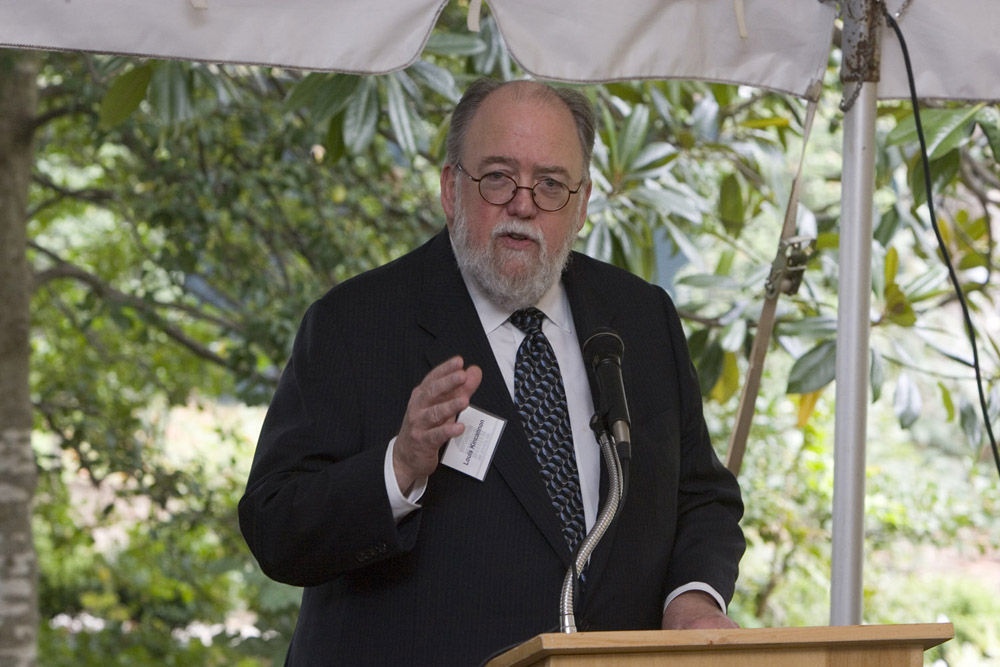Oct. 11, 2006 -- Reaching the first 100 million United States residents required more than 100 years from the first census in 1790. The next 100 million arrived in a little over 50 years. The last 100 million arrived in fewer than 40. Recognizing the 300 million population milestone for the United States and Virginia, the University of Virginia’s Weldon Cooper Center for Public Service today hosted an interdisciplinary conference including speakers Charles L. Kincannon, director of the U.S. Census Bureau; Qian Cai, director of the Center’s Demographics and Workforce Section; Larry J. Sabato, professor of politics; Daphne G. Spain, professor of urban and environmental planning; William Morrish, professor of architecture; and William Harvey, vice president and chief officer for diversity and equity.
Kincannon, who spoke at an invitation-only luncheon, called the 300-million milestone “a moment to pause and reflect about our nation, where we’re going, who we were, who we are.”
The morning session included presentations by two of the center’s demographers and two outside researchers on demographic issues and trends in Virginia. Qian Cai discussed migration to Virginia from other states and other countries, which has accounted for 53 percent of Virginia’s population growth since 2000. According to Cai, recent immigrants from overseas are typically younger and earn less than native-born Americans. Their educational backgrounds also differentiate them from the native born. A higher proportion of recent immigrants than native born have bachelor’s or graduate degrees. At the same time, a higher proportion of immigrants also have less than a high school diploma.
Immigrants, however, who become naturalized citizens tend to have both more education and higher earnings than do the native born.
Michael Spar, who also represents the Center’s Demographics and Workforce Section, reported on astronomical increases in median housing values since 2001 in Northern Virginia (100 percent in Fairfax and 150 percent in Prince William County) and the contrast between skyrocketing housing values and stagnant household incomes. Spar’s data also show increasing numbers of Virginians living in poverty and a steady disparity in earnings between men and women, particularly among those with graduate or professional degree and those who have less than high school diploma.
The conference’s afternoon session featured an interactive, interdisciplinary panel discussion moderated by Sarah B. McConnell, producer and host of the Virginia Foundation for the Humanities radio show “With Good Reason.” Cary Funk, senior project director of the Pew Research Center, opened the session with a talk entitled “The Changing Faces – and Minds – of Americans,” examining how population changes are reflected in changing attitudes and values of our citizens.
Responding to Funk’s presentation were panelists Harvey, Morrish, Sabato and Spain, who addressed a broad range of topics related to the 300-million population milestone. The panelists highlighted changes in national voting patterns, ethnic diversity and challenges in urban planning and environmental planning.
For more information about the conference, including an audio file of the conference keynote address as well as graphics and background materials, please visit the Web site at www.coopercenter.org/demographics/300M/press.php or contact Meredith Strohm Gunter at (434) 982-5585. For general information about the Weldon Cooper Center’s Demographics and Workforce Section, please contact Qian Cai at (434) 982-5581.
Kincannon, who spoke at an invitation-only luncheon, called the 300-million milestone “a moment to pause and reflect about our nation, where we’re going, who we were, who we are.”
The morning session included presentations by two of the center’s demographers and two outside researchers on demographic issues and trends in Virginia. Qian Cai discussed migration to Virginia from other states and other countries, which has accounted for 53 percent of Virginia’s population growth since 2000. According to Cai, recent immigrants from overseas are typically younger and earn less than native-born Americans. Their educational backgrounds also differentiate them from the native born. A higher proportion of recent immigrants than native born have bachelor’s or graduate degrees. At the same time, a higher proportion of immigrants also have less than a high school diploma.
Immigrants, however, who become naturalized citizens tend to have both more education and higher earnings than do the native born.
Michael Spar, who also represents the Center’s Demographics and Workforce Section, reported on astronomical increases in median housing values since 2001 in Northern Virginia (100 percent in Fairfax and 150 percent in Prince William County) and the contrast between skyrocketing housing values and stagnant household incomes. Spar’s data also show increasing numbers of Virginians living in poverty and a steady disparity in earnings between men and women, particularly among those with graduate or professional degree and those who have less than high school diploma.
The conference’s afternoon session featured an interactive, interdisciplinary panel discussion moderated by Sarah B. McConnell, producer and host of the Virginia Foundation for the Humanities radio show “With Good Reason.” Cary Funk, senior project director of the Pew Research Center, opened the session with a talk entitled “The Changing Faces – and Minds – of Americans,” examining how population changes are reflected in changing attitudes and values of our citizens.
Responding to Funk’s presentation were panelists Harvey, Morrish, Sabato and Spain, who addressed a broad range of topics related to the 300-million population milestone. The panelists highlighted changes in national voting patterns, ethnic diversity and challenges in urban planning and environmental planning.
For more information about the conference, including an audio file of the conference keynote address as well as graphics and background materials, please visit the Web site at www.coopercenter.org/demographics/300M/press.php or contact Meredith Strohm Gunter at (434) 982-5585. For general information about the Weldon Cooper Center’s Demographics and Workforce Section, please contact Qian Cai at (434) 982-5581.
Media Contact
Article Information
October 11, 2006
/content/uvas-weldon-cooper-center-hosts-conference-us-population-milestone-us-census-director

